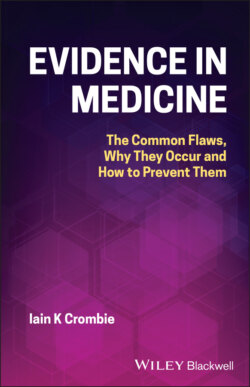Читать книгу Evidence in Medicine - Iain K. Crombie - Страница 8
THEORY AS JUSTIFICATION FOR TREATMENT
ОглавлениеIn ancient times diseases were attributed to supernatural causes, spirits and demons. Treatments involved spells and prayers, or the wearing of amulets, which were intended to drive the malign forces from the patient [4]. Theories gradually evolved towards biological and physical causes of disease, with treatments involving minor surgery and drugs (usually based on plant extracts, minerals and metals). In Western medicine, one of the most influential of these theories was the doctrine of the four humours. It held that good health was enjoyed when four humours (the fluids: blood, phlegm, black bile and yellow bile) were in balance, with an excess of one humour causing disease [5]. Treatment for illness focused on restoring the balance by removing some of the excess humour from the body. This could be achieved by bloodletting (cutting open a vein or by applying a leech), or by losing fluid with a purgative or blistering the skin. This treatment was almost always harmful, although it often appeared to give short‐term relief of the symptoms of acute inflammations [6]. The most notable casualty of bloodletting was George Washington, first president of the United States. He was suffering from a serious upper respiratory tract infection, for which his doctors extracted approximately 2.4 L of blood over about 12 hours. He died 33 hours later, probably from the combination of the infection and the treatment given [5]. When the practice of bloodletting was challenged in the nineteenth century, a leading physician, William Stokes, commented that it was hard to believe ‘that the fathers of British medicine were always in error, and that they were bad observers and mistaken practitioners’ [7]. This cautionary tale of bloodletting suggests that theory and clinical experience may be unreliable guides to the effectiveness of a treatment.
A more recent but widely (mis)used theory was that bed rest was beneficial for a variety of ailments. Its popularity has been traced to a series of lectures in the middle nineteenth century by John Hilton, president of the Royal College of Surgeons [8, 9]. Initially recommended for recovery following orthopaedic procedures [10], it was soon used for conditions including myocardial infarction, pulmonary tuberculosis, rheumatic fever and psychiatric illnesses [9]. Bed rest was particularly popular in pregnancy, where it was recommended for complications such as threatened abortion, hypertension or preterm labour [11]. The theory was that if rest helped to mend broken bones, then it would also heal other organs [9]. The benefits of bed rest were thought to include reduced demands on the heart, conservation of metabolic resources for healing and avoidance of stress [12]. Its use began to be challenged in the middle of the twentieth century, as evidence grew on the adverse effects of bed rest; it is now known to cause impairment of cardiovascular, haematological, musculoskeletal, immune and psychological functions [9, 12]. Bed rest is an example of a treatment based on beliefs about benefit that endured in the face of substantial evidence of harm [8, 11].
